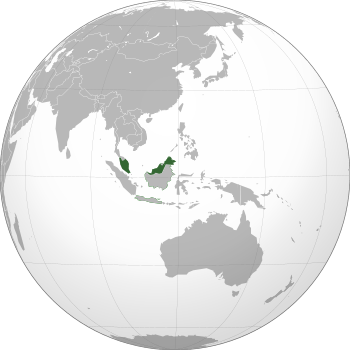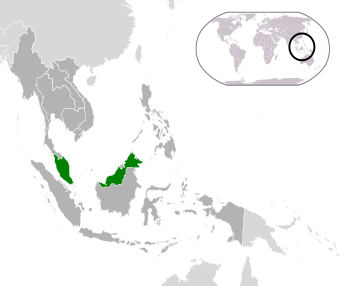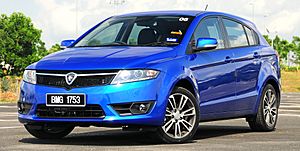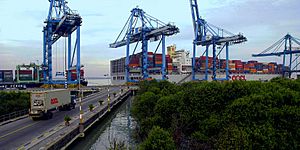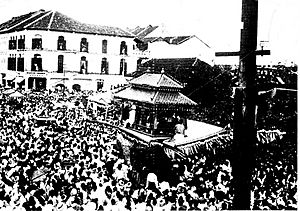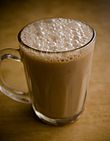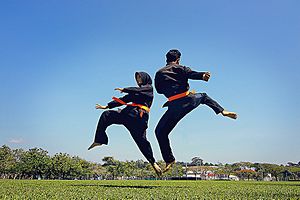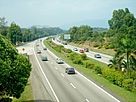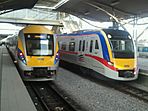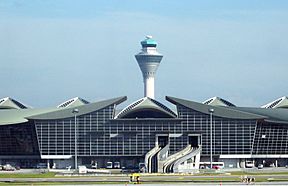Malaysia facts for kids
Quick facts for kids
Malaysia
|
|
|---|---|
|
|
|
|
Anthem: Negaraku
"My Country" |
|
| Capital and largest city
|
Kuala Lumpur 3°8′N 101°41′E / 3.133°N 101.683°E |
| Administrative center | Putrajaya 2°56′N 101°42′E / 2.933°N 101.700°E |
| Official languages | Malay |
| Recognised language | English |
| Ethnic groups
(2021)
|
|
| Religion
(2020)
|
|
| Demonym(s) | Malaysian |
| Government | Federal parliamentary constitutional elective monarchy |
| Ibrahim Iskandar | |
| Anwar Ibrahim | |
|
• President of the Dewan Negara
|
Vacant |
| Legislature | Parliament |
| Dewan Negara (Senate) | |
| Dewan Rakyat (House of Representatives) | |
| Independence
from the United Kingdom
|
|
| 31 August 1957 | |
|
• Sarawak self-governance
|
22 July 1963 |
|
• North Borneo self-governance
|
31 August 1963 |
| 16 September 1963 | |
| Area | |
|
• Total
|
330,803 km2 (127,724 sq mi) (67th) |
|
• Water (%)
|
0.3 |
| Population | |
|
• 2023 estimate
|
33,200,000 (43rd) |
|
• 2020 census
|
32,447,385 |
|
• Density
|
101/km2 (261.6/sq mi) (116th) |
| GDP (PPP) | 2023 estimate |
|
• Total
|
|
|
• Per capita
|
|
| GDP (nominal) | 2023 estimate |
|
• Total
|
|
|
• Per capita
|
|
| Gini (2018) | ▲ 41.2 medium |
| HDI (2021) | very high · 62nd |
| Currency | Malaysian ringgit (RM) (MYR) |
| Time zone | UTC+8 (MST) |
| Date format | dd-mm-yyyy |
| Driving side | left |
| Calling code | +60 |
| ISO 3166 code | MY |
| Internet TLD | .my |
Malaysia is a country in Southeast Asia. It is a federation which has 13 states. It is divided into two parts by the South China Sea. Its mainland is on the Malay Peninsula. It faces the Straits of Malacca on its west coast and the South China Sea on its east coast. The other part of this country, sometimes known as East Malaysia, is on the northern part of the island of Borneo in the South China Sea. Kuala Lumpur on the Malay Peninsula is its capital. The federal capital was recently moved to Putrajaya, a newly created city exclusively designed for administration.
The country is multi-ethnic and multi-cultural, with most people being Malay, but there are also Chinese and Indians. Its official language is Malay written in the Latin alphabet. English is a recognised language. Tamil and Chinese are also often used. There are over 130 other languages spoken in Malaysia, with 94 in Malaysian Borneo and 40 on the peninsula. Islam is the official religion, but non-Malay citizens have the freedom to practice other religions.
Contents
History
Between China and India, Malaysia was an ancient trading place. When Europeans came to this area, Malacca became an important trade port.
The states of Malaysia became a colony of the British Empire, starting with Penang in 1786. The peninsular part became independent on 31 August 1957 as the Federation of Malaya. In 1963, Malaya, Singapore and the Borneo part joined together to become Malaysia. In 1965, Singapore was expelled from the federation and declared independence.
Geography

Malaysia is the 66th largest country by total land area, with a land area of 329,613 km2 (127,264 sq mi). It has land borders with Thailand in West Malaysia, and Indonesia and Brunei in East Malaysia. It is linked to Singapore by a narrow causeway and a bridge. The country also has maritime boundaries with Vietnam and the Philippines. The land borders are defined in large part by geological features such as the Perlis River, the Golok River and the Pagalayan Canal, whilst some of the maritime boundaries are the subject of ongoing contention. Brunei forms what is almost an enclave in Malaysia, with the state of Sarawak dividing it into two parts. Malaysia is the only country with territory on both the Asian mainland and the Malay archipelago. Tanjung Piai, located in the southern state of Johor, is the southernmost tip of continental Asia. The Strait of Malacca, lying between Sumatra and Peninsular Malaysia, is one of the most important thoroughfares in global commerce, carrying 40 per cent of the world's trade.
The two parts of Malaysia, separated from each other by the South China Sea, share a largely similar landscape in that both Peninsular and East Malaysia feature coastal plains rising to hills and mountains. Peninsular Malaysia, containing 40 per cent of Malaysia's land area, extends 740 km (460 mi) from north to south, and its maximum width is 322 km (200 mi). It is divided between its east and west coasts by the Titiwangsa Mountains, rising to a peak elevation of 2,183 metres (7,162 ft) at Mount Korbu, part of a series of mountain ranges running down the centre of the peninsula. These mountains are heavily forested, and mainly composed of granite and other igneous rocks. Much of it has been eroded, creating a karst landscape. The range is the origin of some of Peninsular Malaysia's river systems. The coastal plains surrounding the peninsula reach a maximum width of 50 kilometres (31 mi), and the peninsula's coastline is nearly 1,931 km (1,200 mi) long, although harbours are only available on the western side.
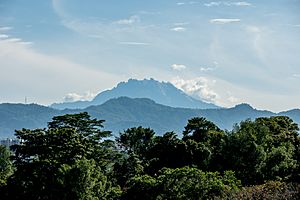
East Malaysia, on the island of Borneo, has a coastline of 2,607 km (1,620 mi). It is divided between coastal regions, hills and valleys, and a mountainous interior. The Crocker Range extends northwards from Sarawak, dividing the state of Sabah. It is the location of the 4,095 m (13,435 ft) high Mount Kinabalu, the tallest mountain in Malaysia. Mount Kinabalu is located in the Kinabalu National Park, which is protected as one of the four UNESCO World Heritage Sites in Malaysia. The highest mountain ranges form the border between Malaysia and Indonesia. Sarawak contains the Mulu Caves, the largest cave system in the world, in the Gunung Mulu National Park which is also a World Heritage Site.
Around these two halves of Malaysia are numerous islands, the largest of which is Banggi. The local climate is equatorial and characterised by the annual southwest (April to October) and northeast (October to February) monsoons. The temperature is moderated by the presence of the surrounding oceans. Humidity is usually high, and the average annual rainfall is 250 cm (98 in). The climates of the Peninsula and the East differ, as the climate on the peninsula is directly affected by wind from the mainland, as opposed to the more maritime weather of the East. Local climates can be divided into three regions, highland, lowland, and coastal. Climate change is likely to affect sea levels and rainfall, increasing flood risks and leading to droughts.
Biodiversity

Malaysia signed the Rio Convention on Biological Diversity on 12 June 1993, and became a party to the convention on 24 June 1994. It has subsequently produced a National Biodiversity Strategy and Action Plan, which was received by the convention on 16 April 1998. The country is megadiverse with a high number of species and high levels of endemism. It is estimated to contain 20 per cent of the world's animal species. High levels of endemism are found on the diverse forests of Borneo's mountains, as species are isolated from each other by lowland forest. There are about 210 mammal species in the country. Over 620 species of birds have been recorded in Peninsular Malaysia, with many endemic to the mountains there. A high number of endemic bird species are also found in Malaysian Borneo. 250 reptile species have been recorded in the country, with about 150 species of snakes and 80 species of lizards. There are about 150 species of frogs, and thousands of insect species. Malaysia's exclusive economic zone is 1.5 times larger than its land area, and some of its waters are in the Coral Triangle, a biodiversity hotspot. The waters around Sipadan island are the most biodiverse in the world. Bordering East Malaysia, the Sulu Sea is a biodiversity hotspot, with around 600 coral species and 1200 fish species. The unique biodiversity of Malaysian Caves always attracts lovers of ecotourism from all over the world.
Nearly 4,000 species of fungi, including lichen-forming species have been recorded from Malaysia. Of the two fungal groups with the largest number of species in Malaysia, the Ascomycota and their asexual states have been surveyed in some habitats (decaying wood, marine and freshwater ecosystems, as parasites of some plants, and as agents of biodegradation), but have not been or have been only poorly surveyed in other habitats (as endobionts, in soils, on dung, as human and animal pathogens); the Basidiomycota are only partly surveyed: bracket fungi, and mushrooms and toadstools have been studied, but Malaysian rust and smut fungi remain very poorly known. Without doubt, many more fungal species in Malaysia have not yet been recorded, and it is likely that many of those, when found, will be new to science.
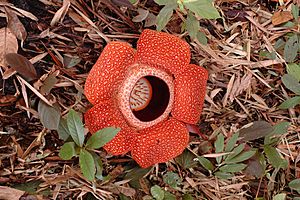
About two thirds of Malaysia was covered in forest as of 2007, with some forests believed to be 130 million years old. The forests are dominated by dipterocarps. Lowland forest covers areas below 760 m (2,490 ft), and formerly East Malaysia was covered in such rainforest, which is supported by its hot wet climate.
There are around 14,500 species of flowering plants and trees. Besides rainforests, there are over 1,425 km2 (550 sq mi) of mangroves in Malaysia, and a large amount of peat forest. At higher altitudes, oaks, chestnuts, and rhododendrons replace dipterocarps. There are an estimated 8,500 species of vascular plants in Peninsular Malaysia, with another 15,000 in the East. The forests of East Malaysia are estimated to be the habitat of around 2,000 tree species, and are one of the most biodiverse areas in the world, with 240 different species of trees every hectare. These forests host many members of the Rafflesia genus, the largest flowers in the world, with a maximum diameter of 1 m (3 ft 3 in).
Economy
Malaysia is a relatively open state-oriented and newly industrialised market economy.
In the 1970s, the predominantly mining and agricultural-based economy began a transition towards a more multi-sector economy. Since the 1980s, the industrial sector, with a high level of investment, has led the country's growth.
International trade, facilitated by the shipping route in adjacent Strait of Malacca, and manufacturing are the key sectors. Malaysia is an exporter of natural and agricultural resources, and petroleum is a major export. Malaysia has once been the largest producer of tin, rubber and palm oil in the world. Manufacturing has a large influence in the country's economy, although Malaysia's economic structure has been moving away from it. Malaysia remains one of the world's largest producers of palm oil.
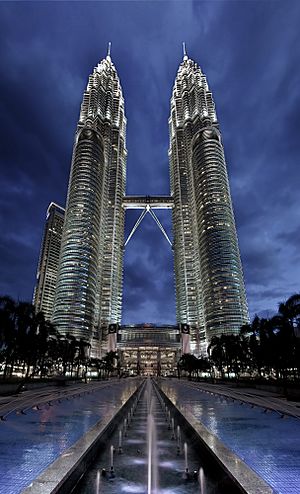
In an effort to diversify the economy and make it less dependent on export goods, the government has pushed to increase tourism to Malaysia. As a result, tourism has become Malaysia's third largest source of foreign exchange, although it is threatened by the negative effects of the growing industrial economy, with large amounts of air and water pollution along with deforestation affecting tourism.
The country is one of the world's largest exporters of semiconductor devices, electrical devices, and IT and communication products. Malaysia began developing its own space programme in 2002, and in 2006, Russia agreed to transport one Malaysian to the International Space Station as part of a multibillion-dollar purchase of 18 Russian Sukhoi Su-30MKM fighter jets by the Royal Malaysian Air Force. The government has invested in building satellites in through the RazakSAT programme.
Politics and economy
Malaysia has 13 states, which are Johor, Kedah, Kelantan, Melaka, Negeri Sembilan, Pahang, Perak, Perlis, Penang, Sabah, Sarawak, Selangor and Terengganu, and three federal territories, Kuala Lumpur, Putrajaya and Labuan. The number of points of the star on the flag represents the number of states Malaysia has, but it has 14 because Singapore was one of the states in Malaysia during its creation. The 14th point now represents the federal territories, called Wilayah Persekutuan. The head of state of Malaysia is known as the Yang di-Pertuan Agong, otherwise called the "King of Malaysia". That title is currently held by Sultan Ibrahim Iskandar of Johor. Malaysia's head of government is the Prime Minister. Its current prime minister is Anwar Ibrahim. It also has a parliament and a court system. It is a founding member of ASEAN. Its economy is steadily growing and it is a relatively rich country in Southeast Asia.
Cities
The following is a list of places in Malaysia. They are in order by the date they were given city status.
- George Town (1 January 1957)
- Kuala Lumpur (1 February 1972)
- Ipoh (27 May 1988)
- Kuching (1 August 1988)
- Johor Bahru (1 January 1994)
- Kota Kinabalu (2 February 2000)
- Shah Alam (10 October 2000)
- Malacca City (15 April 2003)
- Alor Setar (21 December 2003)
- Miri (20 May 2005)
- Petaling Jaya (20 June 2006)
- Kuala Terengganu (1 January 2008)
Religion
Malaysia is a multi-religious society, and Islam is the country's official religion. According to government census figures in 2009, the four main religions are Islam (55.4% of the people), Buddhism (27.2%), Christianity (9.1%, mostly in East Malaysia, i.e., Borneo), and Hinduism (10.8%).
Culture
Malaysia has a multi-ethnic, multicultural, and multilingual society. The original culture of the area stemmed from indigenous tribes that inhabited it, along with the Malays who later moved there. Substantial influence exists from Chinese and Indian culture, dating back to when foreign trade began. Other cultural influences include the Persian, Arabic, and British cultures. Due to the structure of the government, coupled with the social contract theory, there has been minimal cultural assimilation of ethnic minorities.
Fine arts

Traditional Malaysian art was mainly centred on the areas of carving, weaving, and silversmithing. Traditional art ranges from handwoven baskets from rural areas to the silverwork of the Malay courts. Common artworks included ornamental kris, beetle nut sets, and woven batik and songket fabrics. Indigenous East Malaysians are known for their wooden masks. Each ethnic group have distinct performing arts, with little overlap between them. However, Malay art does show some North Indian influence due to the historical influence of India.
Traditional Malay music and performing arts appear to have originated in the Kelantan-Pattani region with influences from India, China, Thailand and Indonesia. The music is based around percussion instruments, the most important of which is the gendang (drum). There are at least 14 types of traditional drums. Drums and other traditional percussion instruments and are often made from natural materials. Music is traditionally used for storytelling, celebrating life-cycle events, and occasions such as a harvest. It was once used as a form of long-distance communication. In East Malaysia, gong-based musical ensembles such as agung and kulintang are commonly used in ceremonies such as funerals and weddings. These ensembles are also common in neighbouring regions such as in Mindanao in the Philippines, Kalimantan in Indonesia, and Brunei.
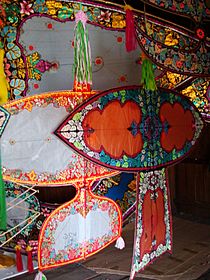
Malaysia has a strong oral tradition that has existed since before the arrival of writing, and continues today. Each of the Malay Sultanates created their own literary tradition, influenced by pre-existing oral stories and by the stories that came with Islam. The first Malay literature was in the Arabic script. The earliest known Malay writing is on the Terengganu stone, made in 1303. Chinese and Indian literature became common as the numbers of speakers increased in Malaysia, and locally produced works based in languages from those areas began to be produced in the 19th century. English has also become a common literary language. In 1971, the government took the step of defining the literature of different languages. Literature written in Malay was called "the national literature of Malaysia", literature in other bumiputera languages was called "regional literature", while literature in other languages was called "sectional literature". Malay poetry is highly developed, and uses many forms. The Hikayat form is popular, and the pantun has spread from Malay to other languages.
Cuisine
Malaysia's cuisine reflects the multi-ethnic makeup of its population. Many cultures from within the country and from surrounding regions have greatly influenced the cuisine. Much of the influence comes from the Malay, Chinese, Indian, Thai, Javanese, and Sumatran cultures, largely due to the country being part of the ancient spice route. The cuisine is very similar to that of Singapore and Brunei, and also bears resemblance to Filipino cuisine. The different states have varied dishes, and often the food in Malaysia is different from the original dishes.
Sometimes food not found in its original culture is assimilated into another; for example, Chinese restaurants in Malaysia often serve Malay dishes. Food from one culture is sometimes also cooked using styles taken from another culture, For example, sambal belacan (shrimp paste) are commonly used as ingredients by Chinese restaurants to create the stir fried water spinach (kangkung belacan). This means that although much of Malaysian food can be traced back to a certain culture, they have their own identity. Rice is popular in many dishes. Chili is commonly found in local cuisine, although this does not necessarily make them spicy.
Holidays and festivals
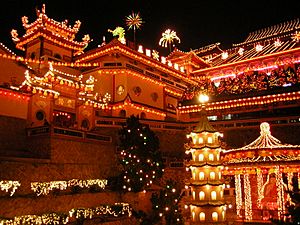
Malaysians observe a number of holidays and festivities throughout the year. Some are federally gazetted public holidays and some are observed by individual states. Other festivals are observed by particular ethnic or religion groups, and the main holiday of each major group has been declared a public holiday. The most observed national holiday is Hari Merdeka (Independence Day) on 31 August, commemorating the independence of the Federation of Malaya in 1957. Malaysia Day on 16 September commemorates federation in 1963. Other notable national holidays are Labour Day (1 May) and the King's birthday (first week of June).
Muslim holidays are prominent as Islam is the state religion; Hari Raya Puasa (also called Hari Raya Aidilfitri, Malay for Eid al-Fitr), Hari Raya Haji (also called Hari Raya Aidiladha, Malay for Eid ul-Adha), Maulidur Rasul (birthday of the Prophet), and others being observed. Malaysian Chinese celebrate festivals such as Chinese New Year and others relating to traditional Chinese beliefs. Hindus in Malaysia celebrate Deepavali, the festival of lights, while Thaipusam is a religious rite which sees pilgrims from all over the country converge at the Batu Caves. Malaysia's Christian community celebrates most of the holidays observed by Christians elsewhere, most notably Christmas and Easter. In addition to this, the Dayak community in Sarawak celebrate a harvest festival known as Gawai, and the Kadazandusun community celebrate Kaamatan. Despite most festivals being identified with a particular ethnic or religious group, celebrations are universal. In a custom known as "open house" Malaysians participate in the celebrations of others, often visiting the houses of those who identify with the festival.
Sports
Malaysia's national sports centre is the Bukit Jalil Sports Complex. Nicol David (squash) and Lee Chong Wei (badminton) are notable athletes from Malaysia. Malaysia won 12 gold medals in the Commonwealth Games 2010 in India, and broke their Commonwealth Games target.
Transport
Malaysia's road network covers 98,721 kilometres (61,342 mi) and includes 1,821 kilometres (1,132 mi) of expressways. The longest highway of the country, the North-South Expressway, extends over 800 kilometres (497 mi) between the Thai border and Singapore. The road systems in Sabah and Sarawak are less developed and of lower quality in comparison to that of Peninsular Malaysia. Malaysia has 118 airports, of which 38 are paved. The official airline of Malaysia is Malaysia Airlines, providing international and domestic air service alongside two other carriers. The railway system is state-run, and covers a total of 1,849 kilometres (1,149 mi). There are also Light Rail Transit in Kuala Lumpur.
Related pages
- States of Malaysia
- List of rivers of Malaysia
- Malaysia at the Olympics
- Malaysia national football team
Images for kids
-
"Malaysia" used as a label for the Malay Archipelago on a 1914 map from a United States atlas
-
The Dutch fleet battling with the Portuguese armada as part of the Dutch–Portuguese War in 1606 to gain control of Malacca
-
Statue of Francis Light in the Fort Cornwallis of Penang, the first British colony in what was to become Malaysia
-
Topographic map of Malaysia; Mount Kinabalu is the highest summit in the country.
-
Kuala Lumpur, the financial centre of Malaysia
-
A traditional house being built in Sabah
See also
 In Spanish: Malasia para niños
In Spanish: Malasia para niños




